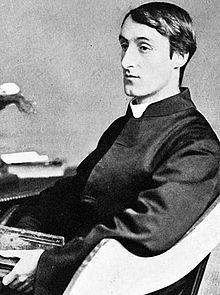Queer Places:
Highgate School, North Rd, Highgate, London N6 4AY, Regno Unito
University of Oxford, Oxford, Oxfordshire OX1 3PA
Newman House, 86 Newman House, St Stephen's Green, Saint Kevin's, Dublin 2, Co. Dublin, Irlanda
Manresa House, Parkstead House, Holybourne Avenue, London SW15 4JD, Regno Unito
Glasnevin Cemetery, Botanic, Dublino, Co. Dublino, Irlanda
Westminster Abbey, 20 Deans Yd, Westminster, London SW1P 3PA, Regno Unito
 Gerard Manley Hopkins SJ (28 July 1844 – 8 June 1889) was an English poet
and Jesuit priest, whose posthumous fame established him among the leading
Victorian poets. His manipulation of prosody (particularly his concept of
sprung rhythm and use of imagery) established him as an innovative writer of
verse. Two of his major themes were nature and religion. The Beginning of the End (1865), The Bugler's First Communion (1879) and Epithalamion (1888)
are cited as examples in Sexual Heretics: Male Homosexuality in English
Literature from 1850-1900, by Brian Reade.
Gerard Manley Hopkins SJ (28 July 1844 – 8 June 1889) was an English poet
and Jesuit priest, whose posthumous fame established him among the leading
Victorian poets. His manipulation of prosody (particularly his concept of
sprung rhythm and use of imagery) established him as an innovative writer of
verse. Two of his major themes were nature and religion. The Beginning of the End (1865), The Bugler's First Communion (1879) and Epithalamion (1888)
are cited as examples in Sexual Heretics: Male Homosexuality in English
Literature from 1850-1900, by Brian Reade.
Some critics have argued that homoerotic readings are either highly
tendentious, or, that they can be classified under the broader category of
"homosociality," over the gender, sexual-specific "homosexual" term. Hopkins’s
journal writings, they argue, offer a clear admiration for feminised beauty.
In his book Hopkins Reconstructed (2000), Justus George Lawler
critiques Robert Martin’s controversial biography Gerard Manley Hopkins: A
Very Private Life (1991) by suggesting that Martin "cannot see the
heterosexual beam... for the homosexual biographical mote in his own eye... it
amounts to a slanted eisegesis". The poems that elicit homoerotic readings can
be read not merely as exercises in sublimation but as powerful renditions of
religious conviction, a conviction that caused strain in his family and even
led him to burn some of his poems that he felt were unnecessarily
self-centred. Julia Saville’s book A Queer Chivalry views the religious
imagery in the poems as Hopkins’s way of expressing the tension with
homosexual identity and desire.
After suffering ill health for several years and bouts of diarrhoea,
Hopkins died of typhoid fever in 1889 and was buried in Glasnevin Cemetery,[16]
following his funeral in Saint Francis Xavier Church on Gardiner Street,
located in Georgian Dublin. He is thought to have suffered throughout his life
from what today might be diagnosed as either bipolar disorder or chronic
unipolar depression, and battled a deep sense of melancholic anguish. However,
on his death bed, his last words were, "I am so happy, I am so happy. I loved
my life."[4]
.jpg)
Newman House
Christopher Ricks notes that Hopkins engaged in a number of penitential
practices, "... but all of these self-inflictions were not self-inflictions to
him, and they are his business—or are his understanding of what it was for him
to be about his Father’s business."[12]
Ricks takes issue with Martin's apparent lack of appreciation of the
importance of the role of Hopkins' religious commitment to his writing, and
cautions against assigning a priority of influence to any sexual instincts
over other factors such as Hopkins' estrangement from his family.[12]
Biographer Paul Mariani finds in Hopkins poems "... an irreconcilable
tension—on the one hand, the selflessness demanded by Jesuit discipline; on
the other, the seeming self-indulgence of poetic creation."[23]

Westminster Abbey, London
My published books:


BACK TO HOME PAGE

- https://en.wikipedia.org/wiki/Gerard_Manley_Hopkins
- Sexual Heretics: Male Homosexuality in English Literature from
1850-1900, by Brian Reade
 Gerard Manley Hopkins SJ (28 July 1844 – 8 June 1889) was an English poet
and Jesuit priest, whose posthumous fame established him among the leading
Victorian poets. His manipulation of prosody (particularly his concept of
sprung rhythm and use of imagery) established him as an innovative writer of
verse. Two of his major themes were nature and religion. The Beginning of the End (1865), The Bugler's First Communion (1879) and Epithalamion (1888)
are cited as examples in Sexual Heretics: Male Homosexuality in English
Literature from 1850-1900, by Brian Reade.
Gerard Manley Hopkins SJ (28 July 1844 – 8 June 1889) was an English poet
and Jesuit priest, whose posthumous fame established him among the leading
Victorian poets. His manipulation of prosody (particularly his concept of
sprung rhythm and use of imagery) established him as an innovative writer of
verse. Two of his major themes were nature and religion. The Beginning of the End (1865), The Bugler's First Communion (1879) and Epithalamion (1888)
are cited as examples in Sexual Heretics: Male Homosexuality in English
Literature from 1850-1900, by Brian Reade..jpg)


